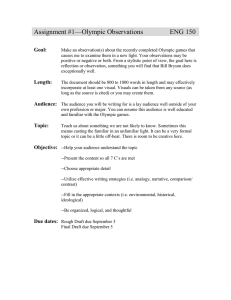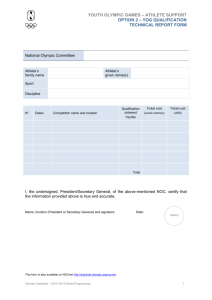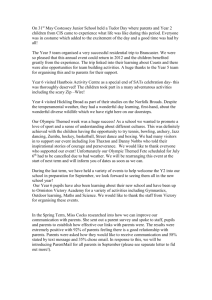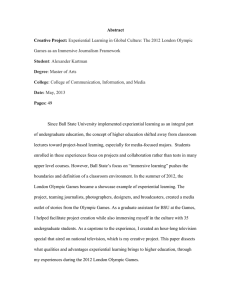Document 14208941
advertisement
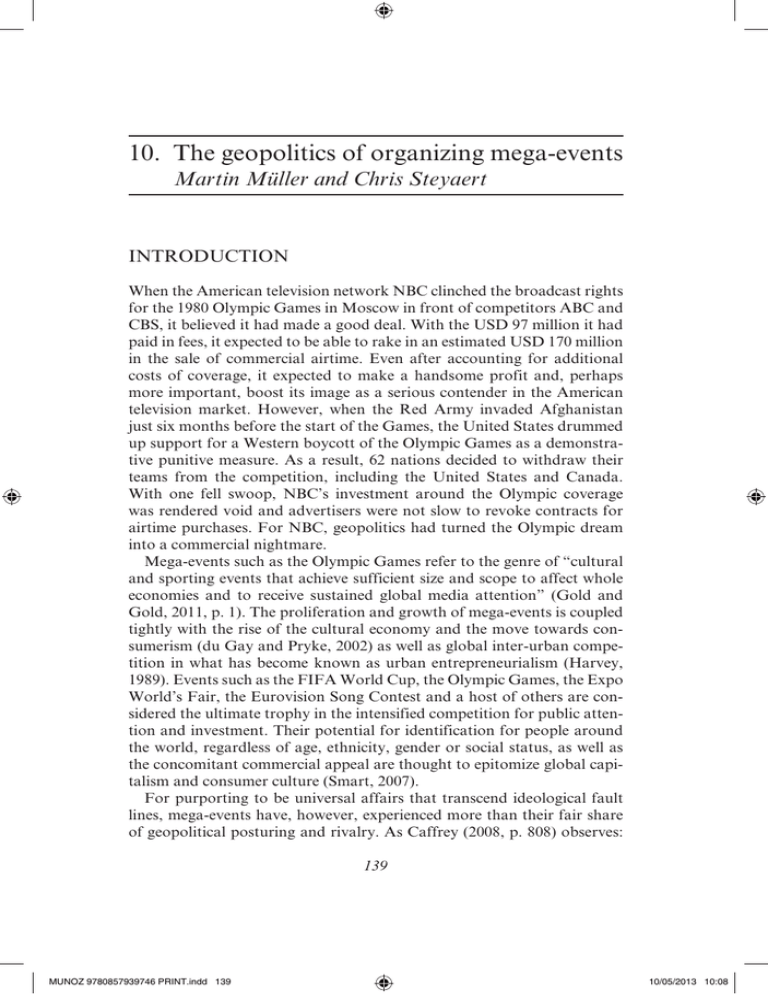
Grahams HD:Users:Graham:Public:GRAHAM'S IMAC JOBS:14199 - EE - MUNOZ:MUNOZ 9780857939746 PRINT 10. The geopolitics of organizing mega-events Martin Müller and Chris Steyaert INTRODUCTION When the American television network NBC clinched the broadcast rights for the 1980 Olympic Games in Moscow in front of competitors ABC and CBS, it believed it had made a good deal. With the USD 97 million it had paid in fees, it expected to be able to rake in an estimated USD 170 million in the sale of commercial airtime. Even after accounting for additional costs of coverage, it expected to make a handsome profit and, perhaps more important, boost its image as a serious contender in the American television market. However, when the Red Army invaded Afghanistan just six months before the start of the Games, the United States drummed up support for a Western boycott of the Olympic Games as a demonstrative punitive measure. As a result, 62 nations decided to withdraw their teams from the competition, including the United States and Canada. With one fell swoop, NBC’s investment around the Olympic coverage was rendered void and advertisers were not slow to revoke contracts for airtime purchases. For NBC, geopolitics had turned the Olympic dream into a commercial nightmare. Mega-events such as the Olympic Games refer to the genre of “cultural and sporting events that achieve sufficient size and scope to affect whole economies and to receive sustained global media attention” (Gold and Gold, 2011, p. 1). The proliferation and growth of mega-events is coupled tightly with the rise of the cultural economy and the move towards consumerism (du Gay and Pryke, 2002) as well as global inter-urban competition in what has become known as urban entrepreneurialism (Harvey, 1989). Events such as the FIFA World Cup, the Olympic Games, the Expo World’s Fair, the Eurovision Song Contest and a host of others are considered the ultimate trophy in the intensified competition for public attention and investment. Their potential for identification for people around the world, regardless of age, ethnicity, gender or social status, as well as the concomitant commercial appeal are thought to epitomize global capitalism and consumer culture (Smart, 2007). For purporting to be universal affairs that transcend ideological fault lines, mega-events have, however, experienced more than their fair share of geopolitical posturing and rivalry. As Caffrey (2008, p. 808) o ­ bserves: 139 MUNOZ 9780857939746 PRINT.indd 139 10/05/2013 10:08 Grahams HD:Users:Graham:Public:GRAHAM'S IMAC JOBS:14199 - EE - MUNOZ:MUNOZ 9780857939746 PRINT Gra 140 Handbook on the geopolitics of business “Games allow each state’s proxies to compete without killing each other.” Although governing bodies such as the IOC and FIFA are steadfast in asserting the supra-political character of the events, the unparalleled global attention they enjoy makes them susceptible to being hijacked for political agendas. At the same time, mega-events are also large-scale business ventures. With the recent shift towards awarding them increasingly to emerging economies, events that have always been characterized by a ‘think big’ frame of mind have become even more spendthrift affairs. With the lack of effective oversight of state spending, China staged the most expensive Olympic Games in history with a total investment of about USD 40 billion and the Winter Olympic Games in Sochi (Russia) 2014 are estimated to clock in at about USD 30 billion. Marketing revenues from the Olympic Games have experienced a continuous growth, doubling between the quadrennial of 1993‒1996 and 2005‒2008 to USD 5.5 billion (IOC, 2012). Organizing mega-events thus inevitably relates conducting business with politics, or indeed geopolitics: the global competition for power. While the Cold War geopolitics of two antagonistic blocs has been supplanted by a fuzzier, multipolar map of global affairs, the rise of emerging economies, in particular the BRIC states (see Chapters 4, 5 and 17 in this handbook), has lent the hosting of mega-events a new geopolitical edge. This chapter uses the Olympic Games, the largest mega-event in terms of total investment and the most complex one in terms of preparation, as a running example to probe into the tight link that organizing mega-events enacts between business and geopolitics. It will do so distinguishing three major nexuses around three actors: nations and the geopolitics of global imagineering; corporations and the geopolitics of expanding markets; and cities and the urban geopolitics of (in-)visible effects. NATION BRANDING AND THE GEOPOLITICS OF GLOBAL IMAGINEERING With an awareness rating in excess of 90 percent, the five interlaced Olympic rings form a desirable icon for brand recognition and identification. The popular association with notions like success, high standards, peace and a continuous tradition of excellence makes the Olympic mark a particularly coveted symbol to be linked with (IOC, 1997). In addition, the unparalleled reach of the Olympic Games offers a platform for broadcasting messages to a global audience. Projections indicate, for example, that 3.6 billion people, that is, 53 percent of the world’s population, watched at least one minute of the Olympic Games in Beijing 2008 (IOC, 2009), MUNOZ 9780857939746 PRINT.indd 140 10/05/2013 10:08 Grahams HD:Users:Graham:Public:GRAHAM'S IMAC JOBS:14199 - EE - MUNOZ:MUNOZ 9780857939746 PRINT The geopolitics of organizing mega-events ­141 while the London Olympic Games were the most-watched TV event ever in US history (The Guardian, 2012). It does not come as a surprise then that many countries take advantage of the Olympic Games to engage in nation branding − “a process by which a nation’s images can be created or altered, monitored, evaluated and proactively managed in order to enhance the country’s reputation among a target international audience” (Fan, 2010, p. 101). The metaphor of putting a city or country on the map, often used in conjunction with hosting the Olympic Games, is indicative of this process of image construction often called ‘imagineering’. In geopolitical terms, nation branding can be interpreted as an exercise in public diplomacy to build what Joseph Nye (1990) introduced as ‘soft power’. It is the ability to affect through attraction, not coercion or payment, in order to obtain the outcomes one wants. Soft power rests on a nation’s culture and values, winning the hearts and minds of the publics of one’s own and other countries. It thus appeals to the affective dimension of identification. It is to this effect that emerging economies in particular often seek to leverage the Olympic Games. They are harnessed as vehicles to signal that the host nation has earned its rightful place among the leading powers as a nation of culture, sport and entertainment – over and above military might (e.g. Russia) or economic prowess (e.g. China). They help to create new symbolic values attached to leisure and consumption, both for an international audience and for the national population (Cornelissen, 2010; Tomlinson, 2010). At the same time, however, Chris Berg critically observes that “the Olympics offer totalitarian or otherwise oppressive governments an opportunity to repurpose the publicity accorded to sport for the benefit of the state and its ideology” (Berg, 2008, p. 17). The hosting of events can thus also serve as a distraction from or legitimization of inequitable policies or instill nationalist sentiments that enhance public loyalty. This is where the universal, internationalist impetus of the Olympic Movement clashes with the political rationalities of nation states. Leveraging the Olympic Games for nation branding, both for an international and an external audience, presented a chance for the 2008 Olympic Games in China. With regular violations of human rights, disreputable business practices and a poor environmental record China is not an epitome of soft power. This did not prevent it from declaring that building soft power was a national goal (Caffrey, 2010, p. 2418). Adopting the slogan “One Games, One World”, China attempted to signify its integration into the international community, having completed a race for modernization. However, it did so underscoring Chinese characteristics and reiterating Chinese exceptionalism: China is not simply to take over Western values, but bring in its own cultural concepts. It seeks to lead MUNOZ 9780857939746 PRINT.indd 141 10/05/2013 10:08 Grahams HD:Users:Graham:Public:GRAHAM'S IMAC JOBS:14199 - EE - MUNOZ:MUNOZ 9780857939746 PRINT Gra 142 Handbook on the geopolitics of business by moral authority – an endeavor that the Olympic Games could help by restoring pride in Chinese traditions and promulgating a set of ideas revolving around Confucianism that would appeal not only to the Chinese population but also to states discontented with Western dominance. In offering an alternative to Pax Americana, China would then espouse a multipolar geopolitics through what Caffrey (2010, p. 2422) calls Lux Sinica. While stressing China’s distinctive characteristics, the hosting of the Olympic Games also responded to dominant negative narratives of China. Utilizing the three mottos of ‘Green Olympics’, ‘High-Tech Olympics’ and ‘Humanistic/People’s Olympics’ (luse aoyun 绿色奥运, keji aoyun 科 技奥运, renwen aoyun 人文奥运), China addressed the prevailing international misgivings about the country head on. International public opinion towards China, however, hardly budged as a result of the Olympic Games. Scholars concluded that if there had been a concerted attempt at building soft power at an international level, it was largely unsuccessful and that the main effect was on the national audience (Manzenreiter, 2010). This outcome might well be related to the intense international scrutiny of the Olympic Games, which also shone a spotlight on the issues that public relations would rather like to hide from view. As Nye (2008, p. 95) states: “if the content of a country’s culture, values, and policies are not attractive, public diplomacy that ‘broadcasts’ them cannot produce soft power. It may produce just the opposite”. Even when boosting the nation is targeting a national rather than a global audience, this might produce a boomerang effect. While the Olympic Games, like many mega-events, try to create a sense of national unity, harmony and pride, they can also reveal intra-national tensions in front of the world camera. The Summer Games in Sydney, for instance, aimed to present Australia as an inclusive country, which makes progress with reconciliation between White and Black Australia, overcoming the racist and economic downgrading of Aboriginals. Especially the participation of Aboriginal performers and the fact that the sprinter Cathy Freeman with an indigenous background lit the Olympic flame was considered as a strong statement on reconciliation (Lenskyj, 2002). However, many observers noticed that the Opening and Closing Ceremonies failed to alter the established narratives about Australia dominated by a white and Western sense of aesthetics where indigenous and multicultural groups appeared merely as an exotic addition rather than a core component (García, 2011). Especially the media beat-up of the Freeman-factor seemed to suggest that her talent was used to the symbolic cause of the organizers instead of giving her a voice of her own (Lenskyj, 2002). When the band Midnight Oil during the closing ceremony appeared on the stage MUNOZ 9780857939746 PRINT.indd 142 10/05/2013 10:08 Grahams HD:Users:Graham:Public:GRAHAM'S IMAC JOBS:14199 - EE - MUNOZ:MUNOZ 9780857939746 PRINT The geopolitics of organizing mega-events ­143 dressed in black with the words “sorry” in white on their t-shirts, this public statement on Australian politics towards indigenous groups did not only embarrass the Australian prime minister and caused a huge polemic about using the Olympics for “political messages”. It also revealed to the world the many tensions and disagreements underlying the glamour show with only a glimpse of what multicultural equality would mean in Australia’s future (Lenskyj, 2002). Harnessing the Olympic Games for national imagineering and branding thus comes with its own set of challenges and silences. THE PARADOXICAL GEOPOLITICS OF NATIONAL ASSERTION AND GLOBAL BUSINESS It is, however, not only states who seek the advantages of the platform of the Olympic Games in the competition for global influence and soft power. Companies too strive to associate themselves with the Olympic Games, typically as sponsors, in efforts to build global brands and get access to new markets with high growth potential. Samsung’s vice-president of worldwide sports marketing, Gyehyun Kwon, has been quoted as saying that the company’s Olympic sponsorship signified that “the Korean firm had evolved from a ‘very mediocre electronics company’, and was ready to go global. It looked for something that would boost brand awareness worldwide” (The Canadian Press, 2010). Each of the 12 global sponsors, all of them large multinationals, paid an average of USD 72 million apiece for the exclusive right of association with the Torino 2006 and Beijing 2008 Olympic Games. Opening up new markets is also one of the unspoken rationales that are driving the choice of hosts of the Olympic Games in the geopolitics of expanding markets (Tomlinson, 2008). And indeed, messages underscoring the economic attractiveness and openness of host countries for business partners and investors are consistently among the strongest in international communication and signaling (Preuss and Alfs, 2011). What is more, in countries where business success often depends on personal relationships and political goodwill, such as guanxi in China or blat in Russia, sponsorship of the Olympic Games can go a long way, not only in raising customer awareness and placing products, but just as much in winning state approval and protection for further ventures. The rhetoric of openness and free competition, however, is not always easy to square with the ambition of nation branding: the ubiquitous presence of global brands and multinational corporations does not sit well with the message of national strength and distinctiveness. The process of organizing the Olympic Games thus always needs to balance the MUNOZ 9780857939746 PRINT.indd 143 10/05/2013 10:08 Grahams HD:Users:Graham:Public:GRAHAM'S IMAC JOBS:14199 - EE - MUNOZ:MUNOZ 9780857939746 PRINT Gra 144 Handbook on the geopolitics of business Note: Built for the 2008 Olympic Games in Beijing, the iconic Bird’s Nest balances global prestige with national distinctiveness. Source: Photograph by Peter23, licensed under a Creative Commons Attribution 3.0 Unported License. Figure 10.1 The iconic Bird’s Nest ­­ showcasing of national achievements and national characteristics with inviting in the global crop of the cream of corporations, architects, artists and so on. The iconic Bird’s Nest, or National Stadium (Figure 10.1), in Beijing is a prime example for this balancing of diverging demands. Its prestigious place both on the central axis of Beijing and at the heart of the Olympic Games required it to signal both national distinctiveness and global status. The winning design from the eminent Swiss-based Herzog and de Meuron architectural practice managed to square this circle: it opted for a global architectural language to convey national ambitions (Ren, 2008). The stadium is built to highest architectural standards and its twisted steel structure brims with allusions to traditional Chinese art and culture. The name itself is a playful reference to the Chinese culinary delicacy, which is among the most expensive food products in the world. Though not uncontroversial, its exceptional design and ready potential for grafting Chinese uniqueness onto its tangled shell has turned it into one of the most memorable visual ambassadors of China – even though it now is underutilized and struggling to pay its way. A similar tension between international openness and nationalist tendencies is evident in the awarding of contracts to deliver construction or MUNOZ 9780857939746 PRINT.indd 144 10/05/2013 10:08 Grahams HD:Users:Graham:Public:GRAHAM'S IMAC JOBS:14199 - EE - MUNOZ:MUNOZ 9780857939746 PRINT The geopolitics of organizing mega-events ­145 services for the Olympic Games. Given that the lavish construction and infrastructure bills for the Olympic Games are commonly picked up by the state, political motivations such as clientelism often interfere with economic calculations when it comes to choosing contractors. Economic nationalism and patronage relationships mean that contracts can be dished out to reward political loyalty or distribute a favor to close allies. Tenders, if required at all, can be rigged to reflect the interest of the national state or indeed for personal gain. The entanglement or even collusion of state and big business in the preparation for the Olympic Games in Sochi 2014 has created opaque dealings and considerable intransparency, often to the detriment of the general public and the environment. Despite the relentless touting of investment opportunities, international companies have turned out to be rather reluctant to jump into this muddy water (Müller, 2011). The economic nationalism at work in the preparation for the Olympic Games thus often subverts messages of market integration and openness to global business. The enormous investment by multinationals in sponsorship of the Olympic Games and of the various national delegations with their own range of (national) sponsors not only brings along privileges but also its own contradictions. There was a public outcry during the London Olympics when members of the general audience who had not been able to gain tickets to the stadia noticed on television that although the games were claimed to be sold out, blocks of seats looked conspicuously empty and competing athletes were missing out on their supporting cheers. It became quickly clear that the seats had not been filled because of corporate sponsors and other VIP invitees not showing up and foreign ticket agencies holding back tickets speculating on higher prices. When it transpired that on the first day alone 12,000 seats had not been filled, not only fans but also athletes expressed their anger on social media, as the latter could often not even get tickets for their families. The mounting dissatisfaction was not assuaged, when it was revealed that the military had been ‘asked’ to fill up the seats. Instead there was talk of a mounting “national embarrassment”, especially in light of the fact that Lord Coe, head organizer, had declared that the stadia would be “stuffed to the gunwales” (The Telegraph, 2012). This so-called ticket fiasco reminded one of the ticketing scandal during the Sydney Olympics, which had “revealed that premium tickets to popular events had been offered through high-priced packages to members of private clubs, while the general public was led to believe that tickets were in short supply” (Lenskyj, 2002, p. 10). This conspicuous absence of equity and fairness in ticket sales is all the more problematic, given that it is tax payers and not sponsors who foot the biggest part of the Olympic bill after all. MUNOZ 9780857939746 PRINT.indd 145 10/05/2013 10:08 Grahams HD:Users:Graham:Public:GRAHAM'S IMAC JOBS:14199 - EE - MUNOZ:MUNOZ 9780857939746 PRINT Gra 146 Handbook on the geopolitics of business URBAN (GEO-)POLITICS AND THE (IN-)VISIBLE EFFECTS OF MEGA-EVENTS Besides nation-branding and business integration in the global economy, a direct importance of mega-events has been urban regeneration and renewal. Urban regeneration can be defined as a “comprehensive integrated vision and action which leads to the resolution of urban problems and which seeks to bring about lasting change in the economic, social, physical and environmental condition of an area” (Roberts and Sykes, 2000, p. 17). For instance, the site for the Olympic Park in Sydney in Homebush Bay provided an opportunity to achieve dramatic infrastructural, environmental and social development in an area with heavily polluted brownfield land. Similarly, the Olympics in London were located in the East End along the Lea Valley with a reputation as a place to be avoided; again this choice of location helped to address “the growing concern for sustainable legacy by using the mega-event as a vehicle for regenerating one of the largest areas of brownfield land in the London region” (Gold and Gold, 2008, p. 311). The Olympic Games form a crucial intervention in the urban development of the hosting city, which goes far beyond the sportive aims and entails a wide spectrum of economic, cultural, environmental and social change. Muñoz (2006) goes as far as to state that the current politics of urbanization cannot be understood fully without considering the contribution of major urban mega-events. With global events impinging on local decision-making, the Olympic Games and other mega-events turn urban politics into urban geopolitics. Mega-events contribute to global inter-urban competition, which makes competitive advantage the most important target for urban development (practitioners). This desire to be competitive can be best understood through a model of governance which replaces managerialism in favor of entrepreneurialism. This new urban entrepreneurialism according to Harvey (1989, p. 8) typically rests “on a public–private partnership focusing on investment and economic development with the speculative construction of place.” Harvey (1989) focuses on three features of this entrepreneurial shift. First, as the influence of business interests increases, so does the number of public–private partnerships. Second, local governments engage in entrepreneurial and speculative risk-taking and assume activities which had been associated solely with the private sector. Third, the focus shifts from a political economy of territory to one of place where attention is drawn to the construction of a specific place and away from the broader problems of a region or territory. These features help us to understand how mega-events like the Olympic Games are inscribed in this entrepreneurial, neoliberal dynamic. Since the various planning and MUNOZ 9780857939746 PRINT.indd 146 10/05/2013 10:08 Grahams HD:Users:Graham:Public:GRAHAM'S IMAC JOBS:14199 - EE - MUNOZ:MUNOZ 9780857939746 PRINT The geopolitics of organizing mega-events ­147 economic problems of the Olympic Games in Montréal, which crippled city finance for the next decades due to a final shortfall of USD 1.2 billion (Gold and Gold, 2008), governance models have increasingly been deployed along private–public partnerships, even turning the local organizing committee into a private–public entity (as this was the case for the Sydney Olympic Bidding Committee, see Waitt, 1999). This neoliberal entrepreneurial model was first put to the test at the Los Angeles Games in 1984, which actually succeeded in turning a profit of USD 225 million dollars (Gold and Gold, 2008). These examples elucidate how organizing mega-events entails the set-up of risky mega-projects which are notorious for “suffer[ing] heavy cost overruns, often fail to deliver the supposed benefits and regularly provoke financial crises” (Gold and Gold, 2008, p. 303). Furthermore, the focus of the city (and the whole nation) acts like a tunnel-vision to consider issues concerning the organization of the Olympics at the expense of other possible, alternative strategies of public policy and economic development. As Hall (2006, p. 67) remarks, sports mega-events “provide an excellent example of the way the production of state and urban public policies has become less concerned with the evaluation of public policies within their own terms of reference than with the macro-policy context and the neoliberal policy problems of competitiveness”. For instance, in Atlanta, a private consortium undertook the organization of the Games. While the Atlanta Games worked to the benefit of global sponsors and the urban business community, they were over(t)ly commercial and fell short of the expectations of poorer communities, which had hoped for better job prospects, roads and improved housing (Gold and Gold, 2008). Once again, the geopolitics of global competition associated with mega-events – competition for markets among big corporations, for image among states and for investment among cities – had trumped more immediate social concerns. In hindsight, the Olympic Games in Barcelona in 1992 are still considered by many to be one of the better examples of urban development. They are perceived as “the blueprint for other cities bidding” (Coaffee, 2011, p. 185), resulting in a wholesale change “of the city’s urban scale that took place during the 1990s, the global promotion of its image that located the city amongst the highest positions regarding global tourism rankings, and the development of on-going urban projects directly inspired by the former Olympic building strategies” (Muñoz, 2006, p. 186). This should not come as a surprise if one acknowledges that the Barcelona planners provided 83 percent of the total investment for urban improvement rather than for sport (Gold and Gold, 2008). There were extensive investments in transport infrastructure, such as metro, coastal railway, and airport, but also in MUNOZ 9780857939746 PRINT.indd 147 10/05/2013 10:08 Grahams HD:Users:Graham:Public:GRAHAM'S IMAC JOBS:14199 - EE - MUNOZ:MUNOZ 9780857939746 PRINT Gra 148 Handbook on the geopolitics of business housing, hotel rooms and office development, and in cultural provisions. Probably most symbolic of its long-lasting legacy has been the extension to a metropolitan waterfront and, in particular, the public access to five kilometers of coastline and new beaches (Gold and Gold, 2008), which was at that time a very deprived and inaccessible area, despite being close to the historic center (Muñoz, 2006). The core of the Barcelona approach has been said to include strong and long-term visioning, an emphasis on urban design as much as on well-funded social programs (Coaffee, 2011). This implied that the urban development was not limited to some specific areas but was able to revitalize and connect several neighborhoods in a physical, cultural and social sense. Coaffee (2011, p. 186) speaks of a holistic approach, which tackled “the problems of poorer neighborhoods, focusing on the interrelated problems of poor education, high crime rates, poor health, unemployment and poor leisure facilities, and a lack of social mixing in disadvantaged neighborhoods”. However, some more invisible negative effects have also been identified, including skyrocketing housing prices, gentrification and brandification. Some people have critiqued that the city has been taken over by an ­­enormous influx of tourists and visitors, which has not helped to achieve deep diversification and integration and sometimes literally oversteps local concerns. The original multicultural and tolerant character of such neighborhoods as El Raval has been lost and new projects such as the Universal Forum of the Cultures, considered a kind of cultural Olympic follow-up, have been seen as elitist and disconnected from local support and acceptance. In recent years, Barcelona has joined those cities wanting to brand themselves as creative and innovative. This hyper-competition between so-called creative cities (Florida, 2002), however, might well turn out to be an own-goal, as cities start to increasingly resemble each other (Steyaert and Beyes, 2009). The urban geopolitics effected by mega-events thus also spurs an increased homogenization and often subordination of urban policies to global demands. CONCLUSION Mega-events are regarded as one of the hallmarks of modernity and have for a long time been able “to integrate industrial and corporate interests with those of government with respect to urban development and imaging” (Hall, 2006, p. 59). While initially World Fairs and Exhibitions were successful internationally in connecting nation-building, education, scientific progress and regional development, it is sports mega-events which are increasingly significant for urban growth and global impact. The organization of mega- MUNOZ 9780857939746 PRINT.indd 148 10/05/2013 10:08 Grahams HD:Users:Graham:Public:GRAHAM'S IMAC JOBS:14199 - EE - MUNOZ:MUNOZ 9780857939746 PRINT The geopolitics of organizing mega-events ­149 events such as the Olympic Games offers an ideal stepping stone for studying the relationship between business and geopolitics. The jostling for new markets and consumers among companies, for new financial, human and cultural capital among cities and for global image projection among states creates a unique geopolitics of business. Business activities such as branding, sponsoring and private-public urban development have to be set up in ways that they manage to deal with the tensions and paradoxes between global demands, national engagement and local meaningfulness. For companies, this means that they need to tread carefully in a megaevent environment that is charged with multiple national, local and social sensitivities. Mega-events have too often been hijacked by commercial or nationalist rationales, turning them into rather delicate ventures. The concept of imagineering that is so often attached to mega-events should not suggest that images can be molded and imposed at will. Rather, businesses, political actors and the local population need to engage in a negotiation process in which all demands are heard. If a mega-event is to have a long-lasting impact, not least in terms of creating a particular image, it will require the support and will have to address the needs of the population. Geopolitics of business thus is not only concerned with the global competition for power among the big players – something the term ‘geopolitics’ might suggest at first glance. Instead, it asks how this competition interacts and impacts processes at the national and local level, and examines the exclusions and silences as well as the possibilities that it creates. REFERENCES Berg, C. (2008). Politics, Not Sport, Is the Purpose of the Olympic Games. IPA Review, 60(3), 15‒18. Caffrey, K. (2008). Olympian Politics in Beijing: Games But Not Just Games. The International Journal of the History of Sport, 25(7), 807‒825. Caffrey, K. (2010). Post-Beijing 2008 and Confucian Outreach in a New Game: China’s Next Move. The International Journal of the History of Sport, 27(14‒15), 2403‒2427. Coaffee, J. (2011). Urban Regeneration and Renewal. In Gold, J.R. and Gold, M.M. (eds), Olympic Cities. City Agendas, Planning, and the World’s Games, 1896–2016 (180‒193). New York: Routledge. Cornelissen, S. (2010). The Geopolitics of Global Aspiration: Sport Mega-Events and Emerging Powers. International Journal of the History of Sport, 27(16‒18), 3008‒3025. du Gay, P. and Pryke, M. (eds) (2002). Cultural Economy. London: Sage. Fan, Y. (2010). Branding the Nation: Towards a Better Understanding. Place Branding and Public Diplomacy, 6(2), 97‒103. Florida, R. (2002). The Rise of the Creative Class. Cambridge, MA: Basic Books. García, B. (2011). Sydney 2000. In Gold, J.R. and Gold, M.M. (eds), Olympic Cities. City Agendas, Planning, and the World’s Games, 1896–2016 (287‒314). New York: Routledge. Gold, J.R. and Gold, M.M. (eds) (2011). Olympic Cities. City Agendas, Planning, and the World’s Games, 1896–2016. Second Edition. New York: Routledge. MUNOZ 9780857939746 PRINT.indd 149 10/05/2013 10:08 Grahams HD:Users:Graham:Public:GRAHAM'S IMAC JOBS:14199 - EE - MUNOZ:MUNOZ 9780857939746 PRINT Gra 150 Handbook on the geopolitics of business Gold, J.R. and Gold, M.M. (2008). Olympic Cities: Regeneration, City Rebranding and Changing Urban Agendas. Geograpy Compass, 2(1), 300‒318. Hall, C.M. (2006). Urban Entrepreneurship, Corporate Interests and Sports Mega-Events: The Thin Policies of Competitiveness within the Hard Outcomes of Neoliberalism. The Sociological Review, 54, 59‒70. Harvey, D. (1989). From Managerialism to Entrepreneurialism: The Transformation of Urban Governance in Late Capitalism. Geografiska Annaler B, 71(1), 3‒17. IOC (1997). Olympic Marketing Matters: The Olympic Marketing Newsletter. Lausanne: IOC. IOC (2009). Games of the XXIX Olympiad, Beijing 2008: Global Television and Online Media Report. Lausanne: IOC. IOC (2012). Olympic Marketing Fact File. Lausanne: IOC. Lenskyj, H.J. (2002). The Best Olympics Ever? Social Impacts of Sydney 2000. Albany: State University of New York. Manzenreiter, W. (2010). The Beijing Games in the Western Imagination of China: The Weak Power of Soft Power. Journal of Sport and Social Issues, 34(1), 29‒48. Muñoz, F. (2006). Olympic Urbanism and Olympic Villages: Planning Strategies in Olympic Host Cities, London 1908 to London 2012. The Sociological Review, 54, 175‒187. Müller, M. (2011). State Dirigisme in Megaprojects: Governing the 2014 Winter Olympics in Sochi. Environment and Planning A, 43(9), 2091‒2108. Nye, J.S. (1990). Bound to Lead: The Changing Nature of American Power. New York: Basic Books. Nye, J.S. (2008). Public Diplomacy and Soft Power. Annals of the American Academy of Political and Social Science, 616(1), 94‒109. Preuss, H. and Alfs, C. (2011). Signaling through the 2008 Beijing Olympics: Using Mega Sport Events to Change the Perception and Image of the Host. European Sport Management Quarterly, 11(1), 55‒71. Ren, X. (2008). Architecture and Nation-Building in the Age of Globalization: Construction of the National Stadium of Beijing for the 2008 Olympics. Journal of Urban Affairs, 30(2), 175‒190. Roberts, P. and Sykes, H. (2000). Urban Regeneration. A Handbook. London: Sage. Smart, B. (2007). Not Playing Around: Global Capitalism, Modern Sport and Consumer Culture. Global Networks, 7(2), 113‒134. Steyaert, C. and Beyes, T. (2009). Urban Entrepreneurship: A Matter of Imagineering? In Lange, B.A., Kalandides, A., Stoeber, B. and Wellmann, I. (eds), Governance der Kreativwirtschaft. Diagnosen und Handlungsoptionen (207‒221). Bielefeld: transcript. The Canadian Press (2010). Olympic Rings World’s Most Recognizable Brand with Protection to Match, 26 February. The Guardian (2012). NBC’s Olympic Coverage was Most-Watched TV-Event in US History, 12 August. The Telegraph (2012). ‘Fiasco’ of the 12,000 Empty Seats, 17 August. Tomlinson, A. (2008). Olympic Values, Beijing’s Olympic Games and the Universal Market. In Price, M.E and Dayan, D. (eds), Owning the Olympics: Narratives of the New China (67‒85). Ann Arbor: University of Michigan Press. Tomlinson, R. (2010). Whose Accolades? An Alternative Perspective on Motivations for Hosting the Olympics. Urban Forum, 21(2), 139‒152. Waitt, G. (1999). Playing Games with Sydney: Marketing Sydney for the 2000 Olympics. Urban Studies, 36(7), 1055‒1077. MUNOZ 9780857939746 PRINT.indd 150 10/05/2013 10:08
